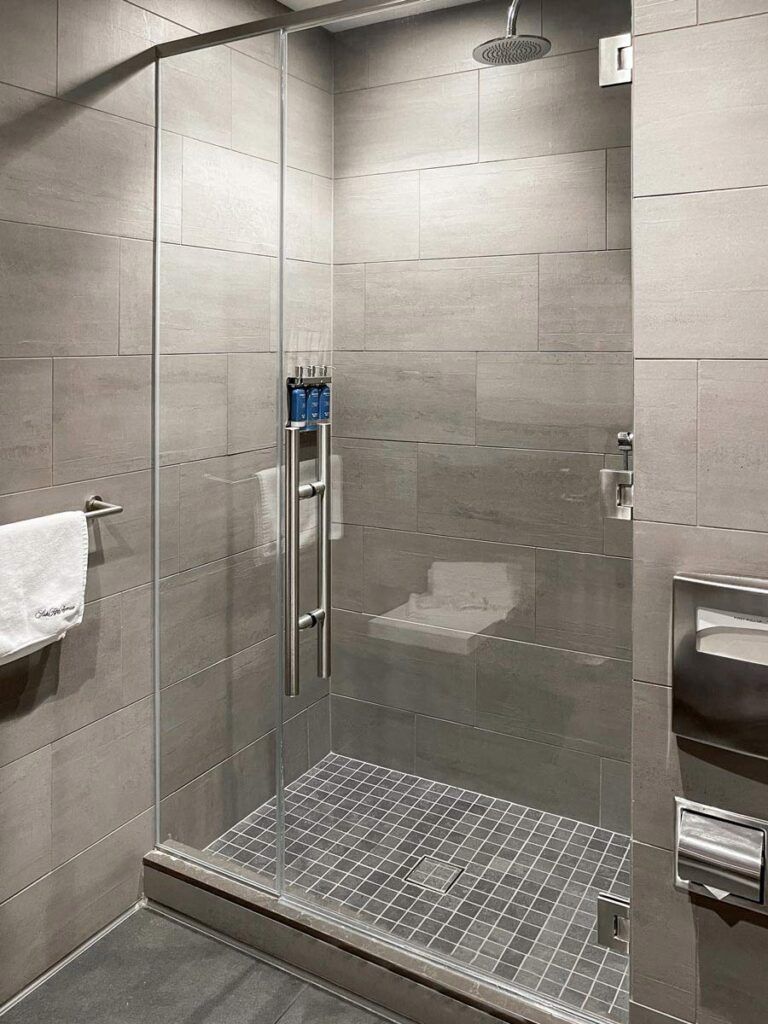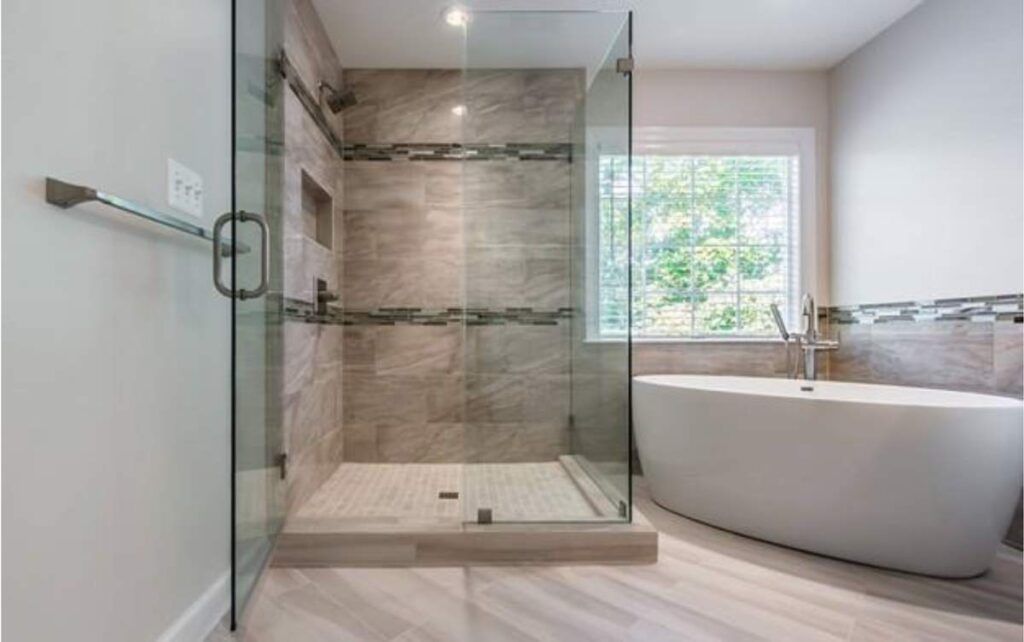Showers and shower doors play an integral role in modern hospitality. Guests usually arrive at a hotel after a lengthy and tiring journey, and the first amenity they often will head for is a hot shower.
Trends in bathroom design change constantly. Bathroom upgrades are an important part of hospitality marketing, and modern designs can quickly become dated and fall out of fashion. Successful hotels emphasize their updated bathroom designs and features in their communications to attract and retain customers.
The US market for shower doors is worth over $3 billion, and growing. Many trends are currently affecting hospitality shower design. Hospitality providers that take advantage of these trends will have an advantage over those that do not.

Why bathroom upgrades are crucial for hospitality marketing
The bathroom is one of the most key features in a hotel’s private accommodation. To feel comfortable in a new space, guests want to experience a bathroom that is clean and fresh. And a bathroom that highlights contemporary elements and is recently renovated will appear cleaner and fresher than an old or outdated bathroom.
Bathroom upgrades are a great selling point for attracting new customers. A customer may choose a hotel specifically to enjoy newly renovated bathrooms. If heading on vacation, travelers may choose to splurge on the hotel whose website highlights its bathrooms’ novel or refreshed shower design.
Bathroom upgrades are also a great strategy for retaining loyal customers. Repeated guests who have seen multiple renovations over the years will be more likely to return to experience more. Over time, they may also come to expect to see upgrades, necessitating regular renovations.
Bathroom upgrades represent cleanliness and ample resources. Bathrooms naturally get dirty and corroded faster than any other feature of a hotel room, so a new bathroom is striking. A new bathroom also indicates that a hotel has resources to spend on the guest experience and suggests to guests that the rest of their services also will be handled appropriately.
Finally, bathroom upgrades help hotels stand out from competitors and amplify their brand. A freshly upgraded bathroom can incorporate elements that reflect positively on or are associated with a hotel’s brand. For example, if a hotel brand is strongly associated with a specific shade of red, they can use tinted glass in that exact color for shower doors.
Frameless glass enclosures
Traditionally, glass showers are encased in a structure-providing frame that connects the shower to the rest of the space. These frames can be cumbersome and visually distract from the essence of the space.
Frameless glass enclosures, on the other hand, create a sleek and modern look for showers. This design trend allows for unobstructed views and emphasizes the beauty of the shower space.
Because these showers lack additional components, they have fewer nooks and crannies, and can be much easier to clean than glass enclosures with frames. They also help to prevent mold from developing in the shower, since frameless enclosures contain fewer moisture-gathering areas where mold could potentially grow.
Some interior designers go a step further and design frameless glass doors with minimal hardware. This trend creates a clean and streamlined look, putting the focus on the glass itself, while providing a seamless and elegant entrance to the shower.
Floor-to-ceiling glass
A floor-to-ceiling glass shower presents a visually stunning design and adds a touch of luxury. It maximizes natural light, enhances the feeling of spaciousness, and provides an immersive shower experience.
The main disadvantage to this type of shower design is the increased cost compared to the size of a typical glass shower. Also, it could require another type of ventilation to be installed within the shower itself. In lower-height shower constructions, steam simply escapes out of the open space around the shower.
Privacy Glass
Privacy glass uses switchable or frosted glass that can be controlled either electronically or manually to adjust its opacity. This allows users to create privacy or natural light, and opacity or transparency, as desired, offering guests full flexibility.
There are several technologies that enable this type of “smart” privacy glass, including:
- Suspended particle displays
- Electrochromic glass
- Nanocrystals
The main disadvantage to providing privacy glass is the increased cost compared to traditional glass.
Textured Glass
Textured glass options add visual interest and a sense of privacy, while still allowing light to filter through. This type of glass can feature various patterns or designs to complement the overall aesthetic.
With textured glass come options for including corporate logos or graphics that relate to hotel brands. Glass textures can be ribbed, frosted, patterned, reeded, fluted or more.
One practical advantage to textured glass is that it may accumulate fingerprints less easily. It may, however, be more challenging to clean when it does get dirty. These effects may vary depending on the selected texture.
Tinted or Colored Glass
Tinted or colored glass can add a vibrant and contemporary element to shower design. This type of glass can be used to create a focal point or to coordinate with the color scheme of the bathroom, adding a unique and personalized touch.
While this type of glass is more expensive than traditional glass, it can add dynamic or dramatic elements to the room. Color can also help project your brand if you have specific colors associated with your business.
Curved or Angled Glass
Curved or angled glass elements can add visually striking effects to a bathroom. These features can create a sense of flow, mimic organic shapes, and contribute to a unique and memorable shower experience.
This type of glass also can be useful if your existing bathroom space is unusual, and one where incorporating a curved or angled enclosure would make better use of the unique space than a simple rectangular enclosure would.
Integrated Glass Shelving
Integrating glass shelving within the shower provides a functional and visually appealing storage solution. It creates a space for guests to organize their toiletries, while maintaining a clean and uncluttered shower space.
This sort of amenity will add to the renovation budget and also to the list of items to be cleaned regularly. It does provide, however, an uncommon luxury that may attract the attention of your customers.
Backlit Glass
Backlit glass features create a captivating and ambient lighting effect in showers. By incorporating LED lighting behind glass panels, the glass emits a soft and diffused glow, which enhances the overall atmosphere of the shower area.
This type of glass is often associated with modern, even slightly futuristic design, and may be more appropriate for some brands than for others. It is also more expensive and may require more maintenance than traditional glass.
Combinations
Many of the types of shower glass enclosures can be combined for added effect.
Textured and colored glass provide maximum expressiveness for your bathroom. It is not as suitable for minimalist interiors, however.
Backlit and colored glass create a vivid, diverse, lit atmosphere for your bathroom space. Again, it may not be as suitable for minimalist interiors, as it can be suggestive of a more maximalist, futuristic look.
Privacy glass and floor-to-ceiling enclosures can be combined to maximize control over light in the room. Since no light can escape from the top of the shower, all light must go through the adjustable privacy glass.
Additionally, these enclosures can be modified by selecting the specific type of glass they are made from, such as tempered glass or laminated glass.
Conclusion
The trends above highlight the use of glazing in shower design to create visually stunning and functional spaces within the hospitality industry. In considering these trends, several themes emerge:
Many trends facilitate minimalism. Frameless glass enclosures, floor-to-ceiling-glass, and privacy glass are all ways of reducing the visual clutter from additional components, such as curtains or decorative hardware.
Another trend is visual expression. Designers incorporate textured glass, tinted glass, backlit glass, and curved or angled glass as striking visual components to a bathroom’s design that could be described otherwise as lackluster.
A final important trend is control of light. Backlit glass, floor-to-ceiling glass, and privacy glass all alter the way that light travels through a room.
Giroux Glass specializes in installing glass, mirrors and other materials in commercial and hotel bathrooms. Contact us today for more information.


